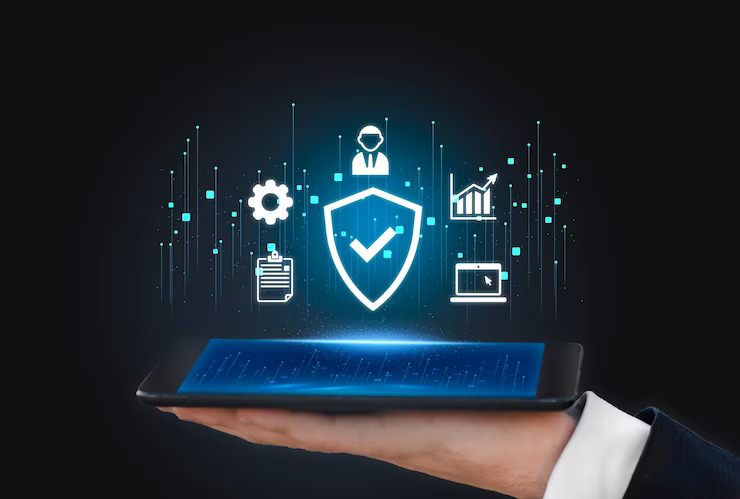Secure the Advantage: Enrol in ISO 27001 Certification
sabitha . Follow
8 months ago
I. Introduction
A. Brief overview of the importance of cybersecurity in the digital age
In today's digital era, the escalating threats of cyberattacks pose serious risks to organizations, encompassing financial losses, reputational damage, and legal consequences. As we increasingly rely on digital platforms, the potential targets for malicious actors expand, emphasizing the critical need for robust cybersecurity measures.
B. Introduction to ISO 27001 Certification and its significance
ISO 27001 Certification stands as a key solution for organizations navigating the complex landscape of cyber threats. It offers an internationally recognized standard for establishing and maintaining an Information Security Management System (ISMS). By adopting ISO 27001, organizations proactively manage and mitigate information security risks, demonstrating a commitment to safeguarding data and enhancing stakeholder confidence.
II. Understanding ISO 27001
A. Explanation of ISO 27001 and its role in information security
ISO 27001 is an international standard that sets out the criteria for establishing, implementing, maintaining, and continually improving an Information Security Management System (ISMS). The primary goal of ISO 27001 is to help organizations systematically manage and protect their information assets. This includes confidential data, intellectual property, employee details, and customer information. The standard provides a holistic approach to managing information security risks and ensures the confidentiality, integrity, and availability of information.
B. Key principles and objectives of ISO 27001 Certification
- Risk Assessment and Management: ISO 27001 emphasizes the identification and assessment of information security risks. Organizations must then implement controls to manage or mitigate these risks, ensuring the security of their information assets.
- Policy and Documentation: Establishing a robust set of information security policies and procedures is a fundamental requirement. These documents guide employees and stakeholders on how to handle information securely.
- Continuous Improvement: ISO 27001 encourages a culture of continuous improvement. Organizations are expected to regularly review and update their ISMS to address changing circumstances and emerging threats.
- Legal and Regulatory Compliance: Compliance with relevant laws and regulations is a critical objective. ISO 27001 helps organizations align their information security practices with legal requirements, reducing the risk of legal consequences.
III. The Certification Process
A. Step-by-step guide on how organizations can pursue ISO 27001 Certification
- Initiation:
- Obtain Management Commitment: Gain commitment from top management to support the implementation of ISO 27001 Certification.
- Appoint a Project Manager: Designate a project manager responsible for overseeing the certification process.
- Scope Definition:
- Identify Assets and Risks: Clearly define the scope of the Information Security Management System (ISMS) by identifying information assets and assessing associated risks.
- Risk Assessment and Treatment:
- Conduct a Risk Assessment: Identify and evaluate information security risks using a systematic approach.
- Develop a Risk Treatment Plan: Formulate a plan to mitigate or accept identified risks in alignment with organizational objectives.
- ISMS Documentation:
- Develop an Information Security Policy: Formulate a policy outlining the organization's commitment to security.
- Create Procedures and Records: Develop procedures and records to support the ISMS, ensuring alignment with ISO 27001 requirements.
B. Overview of the risk assessment and management process
Risk assessment and management are fundamental components of ISO 27001 Certification. The process involves the following key steps:
- Asset Identification:
- Identify and catalog all information assets within the organization, including physical, digital, and intellectual assets.
- Risk Identification:
- Systematically identify potential threats and vulnerabilities that could impact the confidentiality, integrity, or availability of information assets.
- Risk Assessment:
- Evaluate the likelihood and potential impact of identified risks. This involves assigning risk levels based on the combination of likelihood and impact.
- Risk Treatment:
- Develop a risk treatment plan outlining how each identified risk will be managed. Options include risk mitigation, acceptance, transfer, or avoidance.
IV. Benefits of ISO 27001 Certification
A. Improved Cybersecurity Resilience:
- Risk Mitigation: ISO 27001 emphasizes a systematic approach to identifying, assessing, and mitigating information security risks, resulting in improved resilience against potential cyber threats.
- Incident Response: The standard includes guidelines for effective incident response, ensuring organizations are well-prepared to handle security incidents and minimize their impact.
B. Enhanced Customer Trust and Confidence:
- Demonstrated Commitment: Certification serves as tangible evidence of an organization's commitment to maintaining the confidentiality, integrity, and availability of customer data and sensitive information.
- Third-Party Validation: ISO 27001 is recognized globally, and certification provides third-party validation of an organization's adherence to internationally accepted information security standards, fostering trust among customers and partners.
C. Streamlined Business Processes and Increased Efficiency:
- Structured Approach: The implementation of ISO 27001 necessitates a structured and systematic approach to information security management, leading to streamlined business processes.
- Efficiency Gains: By identifying and addressing security risks, organizations can eliminate redundancies, reduce potential disruptions, and optimize their operations, resulting in increased overall efficiency.
V. Overcoming Challenges
A. Common Challenges Faced by Organizations During the ISO 27001 Certification Process:
- Resource Constraints:
- Organizations often face challenges in allocating sufficient resources, including time, personnel, and budget, for the implementation of ISO 27001.
- Resistance to Change:
- Resistance from employees and management to adopt new information security practices and modify existing processes can impede the smooth implementation of ISO 27001.
- Complexity of Documentation:
- Developing and maintaining the required documentation for the ISMS can be perceived as complex and time-consuming, leading to challenges in compliance.
- Lack of Awareness and Training:
- Inadequate awareness and training programs can result in a lack of understanding among employees about the importance of information security and their role in the certification process.
- Integration with Existing Processes:
- Integrating ISO 27001 requirements with existing business processes may pose challenges, especially when organizations already follow different management systems.
B. Strategies for Overcoming These Challenges and Ensuring Successful Certification:
- Top Management Support:
- Secure commitment and active support from top management to ensure the allocation of necessary resources, demonstrating the importance of ISO 27001 to the entire organization.
- Change Management and Communication:
- Implement robust change management strategies to address resistance. Communicate the benefits of ISO 27001 certification clearly, emphasizing its positive impact on the organization's security and overall performance.
- Simplified Documentation Processes:
- Develop streamlined and user-friendly documentation processes. Utilize templates and automated tools to simplify the creation and maintenance of required documentation.
- Comprehensive Training Programs:
- Conduct comprehensive training programs to enhance awareness and understanding of information security policies and procedures among employees at all levels.
- Integration Planning:
- Plan and execute a careful integration of ISO 27001 requirements with existing processes. Identify synergies to ensure a seamless incorporation of information security practices into day-to-day operations.
VI. Continuous Improvement
A. The Importance of Ongoing Monitoring and Improvement in Information Security:
- Dynamic Threat Landscape:
- Information security is a dynamic field, and the threat landscape is constantly evolving. Continuous monitoring is crucial to adapt to new threats and vulnerabilities that may emerge over time.
- Organizational Changes:
- Businesses undergo changes, such as expansions, technological upgrades, or process modifications. Continuous improvement ensures that the Information Security Management System (ISMS) remains aligned with the evolving organizational landscape.
- Incident Response Enhancement:
- Regular monitoring allows organizations to refine and enhance their incident response capabilities. Learning from past incidents helps in developing more effective strategies to mitigate and respond to future security breaches.
- Regulatory Updates:
- Information security regulations and compliance requirements can change. Continuous monitoring ensures that the organization stays abreast of regulatory updates and remains compliant with the latest standards.
- Technology Advancements:
- The introduction of new technologies may bring both opportunities and risks. Ongoing improvement allows organizations to leverage technological advancements while managing associated security risks.
VII. Conclusion
A. Recap of Key Points
In summary, we've covered the essentials of ISO 27001 Certification, from understanding its framework to dissecting the certification process. Emphasis was placed on the critical role of an effective Information Security Management System (ISMS) and the broader benefits, extending beyond security to operational efficiency and stakeholder trust. This recap encapsulates the key points, highlighting the significance of ISO 27001 Certification in enhancing information security and overall organizational resilience.
B. Competitive Advantage and Long-Term Benefits
ISO 27001 Certification not only shields organizations from evolving cyber threats but also provides a tangible competitive advantage. The commitment to information security enhances credibility, fortifies resilience, and fosters long-term benefits such as improved operational processes. This certification becomes a strategic asset, positioning organizations as leaders in their industries.
C. Encouragement for Action
In conclusion, we urge organizations to proactively pursue ISO 27001 Certification. The investment in information security pays dividends in terms of safeguarding data, building trust, and securing a competitive edge. Embracing this standard is not merely a compliance requirement but a strategic move towards a secure and resilient future. By taking this step, organizations signal their dedication to the highest information security standards, cultivating a reputation of trustworthiness in the digital landscape.
Recommended topics
Recommended from Guest Post
packe rsandm
Exploring Free Things You Must Do Each Time You Visit A City Destination
February 24, 2024Gavin Flannery
Gavin Flannery: Pioneering Digital Marketing Excellence at My Robot Monkey
February 26, 2024
The Code Technologies



